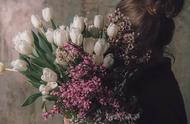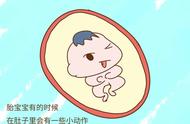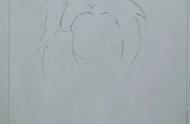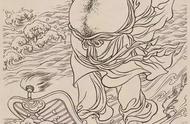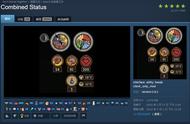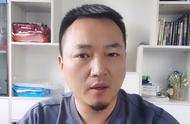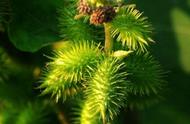孙博文与这个时代的相遇多少有些意外,因其意外,他与这个时代所碰撞出的火花才格外地眩目。2020年中国美术馆、2021年山东美术馆的两次展览后,向来与美术界、学术界并未有太多交集的孙博文,依托其大泼彩绘画而引起了广泛的社会反响,其声名日隆,甚至超过了1980年代对黄秋园、陈子庄的发现。与此形成巨大反差的是孙博文生前的孤寂——终其一生,孙博文都是孤悬于美术界之外的“基层艺术家”。其情形与他的偶像梵高有些类似:一个在南法阳光照耀下的旷野与麦田中孤守;一个在山东的乡野与岱岗之间游走。两人皆可用勃兰兑斯评价拜伦的话来加以描述一颗没有氛围的“星星”。
Sun Bowen’s encounter with this era is somewhat unexpected, so the sparks generated by his collision with this era are particularly dazzling. After two exhibitions at National Art Museum of China in 2020 and Shandong Art Museum in 2021, Sun Bowen, who had never had much interaction with the art or academia fields, aroused strong social responses with his big splash color paintings; his reputation is ever rising and even has surpassed the discoveries to Huang Qiuyuan and Chen Zizhuang in the 1980s. In contrast, Sun Bowen was lonely - in all his life, he was always a “grassroots artist” isolated from the art world. His situation is somehow similar to his hero - Van Gogh: The latter lived lonely in the open countries and wheat fields in southern France and the former wandered between the countries and hillocks in Shandong Province of China. They both can be described by Brandes’ comment on Byron – “A Star Without Atmosphere”.

▲《山高禅意浓》
358cmX143cm
2001年作
▲ Deep Zen Spirit in High Mountains
358cmX143cm
Created in 2001
从结构上讲,两次展览均有一个明显的缺陷,那就是早期花鸟、山水作品的缺席。显而易见,这个缺陷让观众无法了解孙博文早期创作的面貌,更无法理解其早期作品与晚期作品之间的逻辑关系。为了弥补这一缺憾,在这里必须强调:依早期与晚期作品的性质而论,事实上存在着两个不同的孙博文:日常的、世俗的、作为文人画家的孙博文;半清醒的、半癫狂的、作为精神遨游者的孙博文。前者是虚静的、入世的,以寄情花鸟、山水来完成自己的艺术理想;后者则是狂狷的、超世的,飘渺如孤鸿,在遨游形而上世界无尽的历程中,探寻生命的归宿。
In terms of structure, there was an obvious defect in both exhibitions, i.e., there were no early works of flowers, birds and landscapes. Obviously, this defect makes it impossible for the audiences to understand the profile of Sun Bowen’s early works, and not even the logical relationship between his early and later works. In order to make up for this defect, it must be emphasized here that, in terms of the natures of early and late works, there are actually two different Sun Bowen profiles: the ordinary and secular Sun Bowen as a literati painter and the half-awake and half-delirious Sun Bowen as a spiritual wanderer. The former is quiet, secular, and entrusting his artistic pursuits on the paintings of flowers, birds and landscapes, and the latter is arrogant, transcendental, wandering like a lonely swan goose, and exploring the destination of life in his endless journey in the metaphysical world.
孙博文晚年所作,多巨幛大幅。观者置身于其中,犹如梭巡于精神的密林。在他们的感受中,那些弥散着神秘气息的、连续性的、非现实的宇宙图像,不再是通常意义上的美术作品,而更像是对宇宙、对生命终极归宿的叩问。很显然,这种感受从本质上讲,是反日常的,更接近于某种宗教情感。因而,与通常的美术展览相比,孙博文展览的现场更像是一个巨大的精神道场。
The works of Sun Bowen in his later years are mostly large and massive, in which the audiences are always immersed, as if they are traveling through a spiritual forest. In their perception, those mysterious, continuous and non-realistic images of the universe are no longer art works in the common sense, but more like a questioning about the universe and the ultimate destination of life. It is clear that, in essence, this feeling is unusual and closer to some religious emotion. Therefore, compared with the common art exhibitions, Sun Bowen’s exhibition is more like a huge spiritual ashram.
展览带来的一个质疑值得关注:在一个乡土文化尽毁,文化土壤充分盐碱化的地域中,如何生长出了孙博文这样参天的乔木?众所周知,许多年来,曾诞生过齐白石、黄宾虹的丰厚腴润的民间文化生态已被破坏殆尽。从这个角度上讲,孙博文的人生、艺术就成了一个难以破解的谜题。有趣的是,其巨大的诱惑力也正在于此。
The exhibition brings up a question that deserves attention: How did such a towering tree as Sun Bowen grow in a region where local culture was completely destroyed and the cultural soil was fully deteriorated? As we all know, over the years, the rich and fertile folk culture ecology that gave birth to Qi Baishi and Huang Binhong has been destroyed. From this point of view, Sun Bowen’s life and arts have become a difficult puzzle to solve. Interestingly, this is where its great allure lies.

▲《袖卷红云水上生》
143cmX360cm
2001年作
▲ Red Clouds Wound up by the Sleeve Rising from the Water
143cmX360cm
Created in 2001
一、生命的觉者
I. The Perceiver of Life
近些年来,即便对中国当代艺术一知半解的人亦可看出其问题所在:除了市场上那些弄虚作假的数字,以及艺术家们在财富榜上相互攀比的*外,当代艺术在其他方面——比如,在价值建构和原创性方面,则一无是处。自从资本、利己主义哲学和科技理性剪断当代艺术的超验性脐带后,艺术家们似乎再也没有兴趣仰望星空,为信仰而战了。主体的俗化,作品的矫饰化、技术化,已成为当代艺术的基本表征。然而,“现代艺术的真正问题是信仰问题”,当代艺术亦如此。倘若以此为坐标,孙博文出道即巅峰这一现象便变得可以理解,在某种程度上,他本人及其作品满足了知识阶层、公众对当代艺术家及当代艺术的集体想象:以主体生命的纯真性去感知与生成形而上的世界,让灵魂重返艺术真理的位置,并在那里建构信仰体系与救赎功能。
In recent years, the problem with Chinese contemporary art has become apparent even to those with a rudimentary understanding of it: apart from the falsified numbers in the market and the desire of artists to compete with each other in terms of wealth, contemporary art has failed in other aspects—for example, in terms of value construction and originality. Since capital, egoistic philosophy and technological rationality have cut the transcendental umbilical cord in contemporary art, artists no longer seem to be interested in looking up to the vast galaxy and fighting for their faith. The vulgarization of the subject and the pretentious and technicalization of the works have become the basic features of contemporary art. However, "the real problem of modern art is the problem of faith," and this is also true of contemporary art. If we take this as a coordinate, the phenomenon of Sun Bowen's debut at the peak becomes understandable. To a certain extent, he and his works fulfill the collective imagination of the intellectual class and the public for contemporary artists and contemporary art: to perceive and generate the metaphysical world with the purity of the subject's life, to bring the soul back to the artistic truth, so as to construct the belief system and redemption function.
毕竟,对世俗社会的芸芸众生而言,一个浑沦博大、空明无执的超验世界,既能在视觉上提供前所未有的美感,又能在精神上为心灵寻觅到栖息之地。同时,一个超验性主体远比一个世俗的利己主义者更符合他们对“艺术家”的期待。只要我们简单回顾一下自1990年代以来,那些具有超越性品质的艺术家如何在消费主义社会中整体性崩溃的事实,便可理解公众对理想主义人格的渴望。
After all, for all beings in the secular society, a transcendental world that is vast, empty, and non-attached can not only provide an unprecedented aesthetic feeling visually, but also a spiritual habitat for the soul. At the same time, a transcendent subject is far more in line with their expectations of an "artist" than a secular egoist. As long as we briefly review the fact that since the 1990s, how those artists with transcendent qualities have collapsed in the consumerist society as a whole, we can understand the public's desire for idealistic personalities.
如此一来,中国当代艺术的全部问题可以归结于此:如何重建以生命纯真性感知为核心的超越性主体?
In this way, all the problems of Chinese contemporary art can be summed up as follows: how to rebuild the transcendent subject with the perception of the purity of life as the core?
如果孙博文的人格、作品能提供一个答案甚至标准答案的话,毫无疑问,那将是对中国当代艺术的一个嘲弄——尽管是无意的。
If Sun Wenbo's personality and works can provide an answer or even a standard answer, it will undoubtedly be a mockery of Chinese contemporary art—although it is unintentional.

▲《远烧入穹》
441cmX144cm
2002年作
▲Far Burning Red Into the Sky
441cmX144cm
Created in 2002
孙博文20世纪60年代入山东美专学习,师从于关友声、黑伯龙、王企华诸师。在这里研习中西画法并不是孙博文的唯一所获,比这更重要的,是他从黑伯龙等人那里领悟到了变革旧法、鼎力维新的艺术精神。作为上海美专的毕业生,黑伯龙不仅将海派的现代中国画技术体系带到了齐鲁,并把作为“新兴艺术策源地”上海美专的核心理念如“国魂”“个性”植入了齐鲁中国画体系,而且为山东美专提供了以“闳约深美”为内在逻辑的教学理念。细究起来,甚至可以说,孙博文的成长,完全符合“闳约深美”所规约的路径——在语言学家、国学家、书法篆刻家蒋维崧那里,孙博文完成了传统哲学、古文字、诗词及书法篆刻的修习,尔后由“闳”趋“约”,集中于花鸟、山水的创作。在同乡花鸟画大家崔子范的引导下,日益向花鸟、山水的纵深领域推进,究本穷源,辉光日新,渐趋至美圣境。“‘美’指的是一种理想境界,求学的人只能处于永恒的探索之中。美的疆域阔大无限。”
Sun Bowen entered Shandong University of Arts in the 1960s to study under Guan Yousheng, Hei Bolong, and Wang Qihua. Studying Chinese and Western painting methods here is not the only thing Sun Bowen has gained. What is more important than this is that he has learned from Hei Bolong and others the artistic spirit of reforming the old methods and vigorously restoring the new. As a graduate of Private Shanghai Academy of Fine Arts, Hei Bolong not only brought the Shanghai-style modern Chinese painting technology system to Shandong, but also implanted the core concepts of "source of emerging art”, namely Private Shanghai Academy of Fine Arts, the “national soul" and "personality", into Shandong Chinese painting system, and provided Shandong University of Arts with a teaching concept based on the internal logic of “broad knowledge; careful choices on the basis of extensive collection; intensive study; perfect state”. Looking at it carefully, it can even be said that Sun Bowen's growth is fully complied with the path stipulated by “broad knowledge; careful choices on the basis of extensive collection; intensive study; perfect state” —from Jiang Weisong, a linguist, sinologist and calligraphy seal carver, Sun Bowen completed the practice of traditional philosophy, ancient characters, poetry and calligraphy seal carving, and then moved from “broad knowledge” to “careful choices on the basis of extensive collection”, focusing on the creation of flowers, birds and landscapes. Under the guidance of Cui Zifan, a master of flower-and-bird painting in the same hometown, he has gradually advanced into the in-depth field of flowers, birds and landscapes, and has gradually reached the sacred realm of beauty. “‘Beauty’ refers to an ideal state in which those who study can only be in eternal exploration. The territory of beauty is vast and infinite.”



